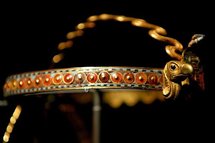Tut probe shows power of technology -- but raises questions too
Richard Ingham
PARIS, Richard Ingham- On November 26 1922, the British egyptologist Howard Carter peered through a tiny hole into the tomb of Tutankhamun in the Valley of the Kings.
"I see wonderful things," he gasped as he glimpsed a profusion of gold and ebony, hidden for more than 30 centuries.
The mummy, the gorgeous funeral mask, coffin and artefacts that accompanied the boy king into the afterlife yielded an extraordinary insight into the long-lost world of the pharaohs.

A close up view of the diadem on display during 'Tutankhamun and the Golden Age of the Pharaohs'
That without even laying a finger on the precious relic, archaeologists could get a 3D image of Tutankhamun's remains?
That a tiny sample of preserved tissue could shed light on the monarch's lineage and help explain the mystery of his demise?
In a major investigation into Tutankhamun published on Tuesday, Egyptian scientist Zahi Hawass and others used genetic fingerprinting to build a family tree thanks to DNA variations handed from generation to generation.
The technique leapt into the lexicon of history sleuths in 2004.
That was the year genetic material coaxed from a pickled heart in a French cathedral, and compared to a strand of hair cut from the head of Marie-Antoinette, proved that a child who died in prison at the height of the French Revolution was indeed the uncrowned 10-year-old king, Louis XVII.
For two centuries, French royalists had claimed the child had been spirited from his cell by a Scarlet Pimpernel character, a notion that unleashed a rash of pretenders to the throne.
A year ago, scientists in Germany published a draft of nearly two-thirds of the genome of the Neanderthal. It suggests this strange, extinct branch of humans did not interbreed with modern Homo sapiens.
And last week, Danish researchers, working on a sample of 4,000-year-old hair found in a long-abandoned settlement in Greenland, were able to say it came from the head of a man who most probably had brown eyes and brown skin and died quite young.
He had shovel-form front teeth and had dry earwax, which increased susceptibility to ear infections.
Even better: a comparison with the DNA of ethnic groups alive today indicates the man's tribe hailed from... Siberia. It had crossed the Bering Strait into Alaska and headed east to colonise Greenland.
More secrets are set to emerge in the coming years, teased from South American mummy hair or other preserved material, said University of Copenhagen investigator Eske Willerslev.
"I won't say it will become routine, but with the prices for (gene) sequencing dropping the way they are, I think it will be something that we will see much more in the coming five years," he said last week.
One biotech startup, Pacific Biosciences in Menlo Park, California, told AFP last year that by 2013 it should be able to unravel a genome in a quarter of an hour for under a thousand dollars.
By way of comparison, the first complete sequencing of the human genome was published in 2003 after a 13-year-effort that cost around three billion dollars.
There is a caveat, though. Many ancient samples may be unsuitable for DNA sequencing, as they may have been contaminated through handling and often their genome is fragmented or incomplete, notes Willerslev.
As sleuthing tools become more widespread, ethical questions are bound to emerge.
What is considered a decent lapse of time before scientists can carry out a "historical" inquiry on human remains?
And should great figures be entitled to the same protection of privacy as private individuals?
"All historians are guilty of enjoying reading the mail and personal materials of others," said Howard Markel of the University of Michigan in the Journal of the American Medical Association (JAMA), where the Tutankhamun probe was published.
"The penetrating wonders of 21st-century medical science... (require) pondering all the ethical implications of such inquiries to avoid opening a historical Pandora's box."
--------------------------------------------------------------------